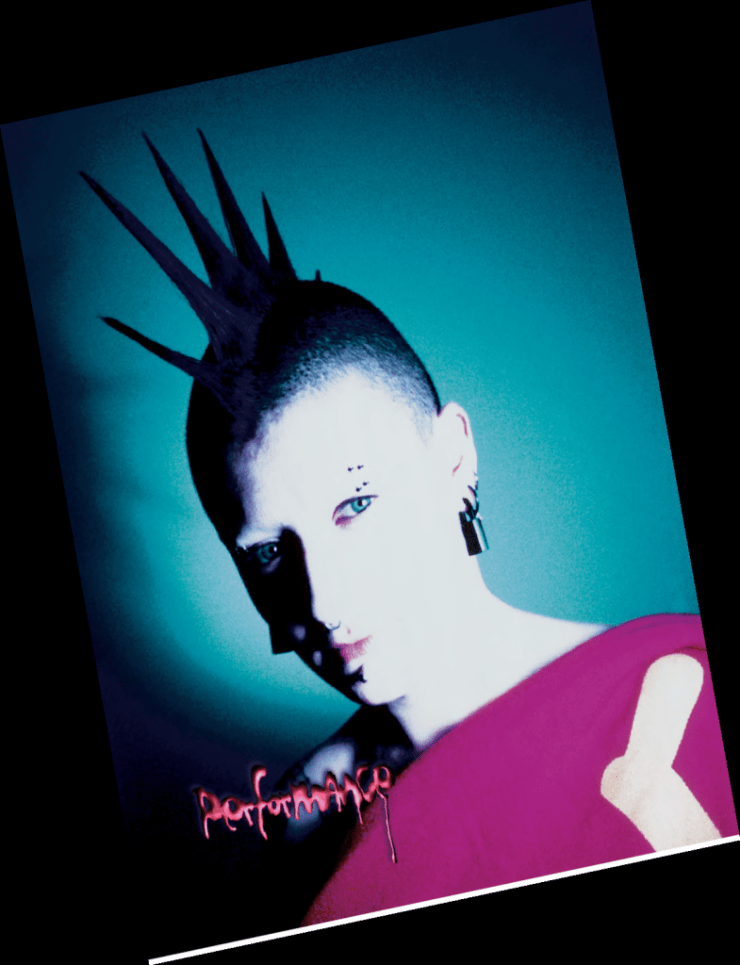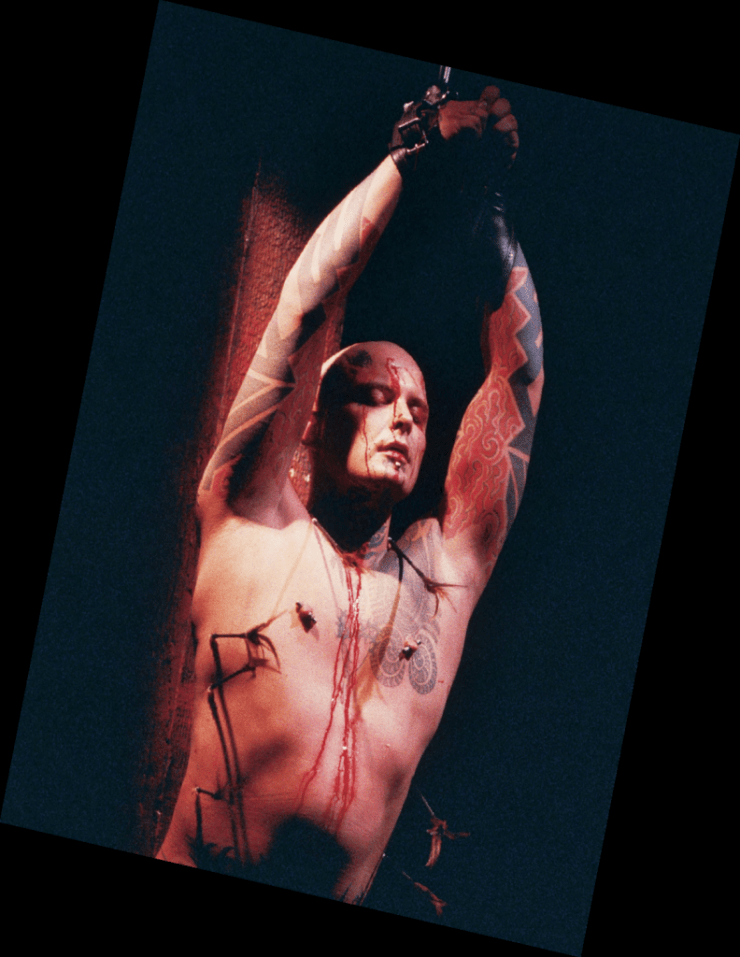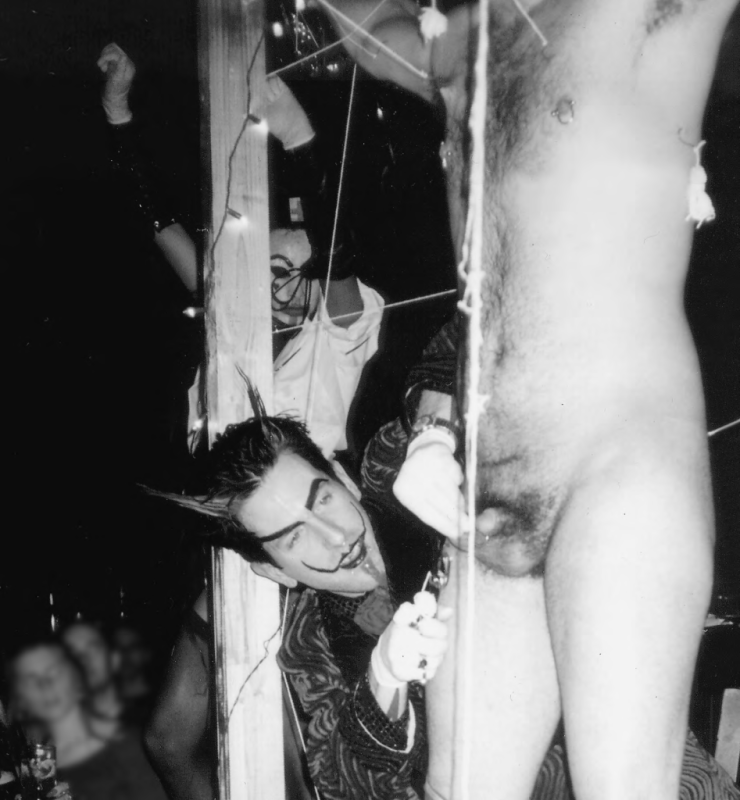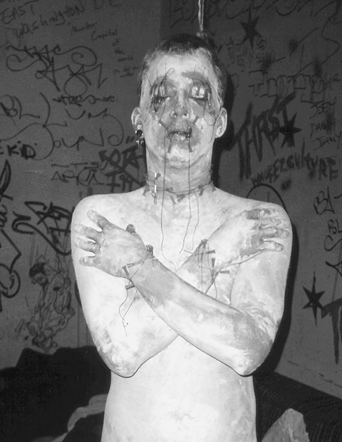The following pages feature articles from issue 49 of Piercing Fans International Quarterly, 1992. Over 30 years have passed, but the art was as vital then as it is today. Used with the permission of Gauntlet Enterprises.

Cover of PFIQ issue 49 with Spike the Holocaust Girl photographed by Christine Kessler.

Back cover of PFIQ Issue 49 featuring Ron Athey in the “st. Sebastian Enlightened in a Zen Garden” scene of The Casting Out/A Crown of Thorns performance at L.A.C.E. Los Angeles, November 13, 1992. Photo by Dikon Lewis.
Paul King

Image from David Wojnarowicz photo series Silence Through Economics.

In demonic drag Paul King torments Andrew Fucker during the San Francisco performance of Man’s Ruin.
Motivation and presentation may have changed, but the act of the artist using bodily fluids and perforated flesh as a vehicle of expression is nothing new. In the 70s, artist/groups such as Marina Abromovic and Coum Transmissions, later known as Throbbing Gristle, incorporated blood letting in their performances. In the 80s blood performances attracted greater atten tion. The artist Stelarc suspended himself from a crane over the streets of Copenhagen, held by giant hooks through his flesh.
Portraying the human body as “obsolete,” he gained international notoriety. The collaboration team of Ron Athey and Rozz Williams, known as Premature Ejaculation, was filleting and nailing themselves—and a few road kill—for Los Angeles audiences. On the subject of nails, performance artist Bob Flannigan would hammer the head of his dick to a board and then pry the nail out. AIDS activist/writer/ performance artist David Wojnarowicz utilized similar techniques when he stitched his lips shut as a visual testimony to the concept “Silence = Death.”
Through literature, music videos, high fashion, media sensationalism and governmental hysteria, the sub-culture of permanent and performance piercing has penetrated the mainstream. Don’t be surprised when Barbie starts sporting a “belly button ring.” Increased public attention, both negative and positive, has enabled cutting edge artists like Ron Athey to break from the underground circuit to “proper” performance theaters. Performing in established art environments with greater budgets, the artist can more accurately and elaborately bring their vision to stage.
Performance piercing in the 90s originated in the nightclub. At L. A.’s nightclub “Fuck!”, friends of the promoters included S/M practitioners, who started bringing their sex lives to the dance podium. Performers such as Elayne Binnie, Ron Athey and Crystal Cross were at the forefront.
Fetishism and exhibitionism were the primary motivations. Initial responses ranged from shock and revulsion, to admiration and lust. Most of what you see in nightclubs these days has become narrowly focused on shock value.
Don’t get me wrong, I love a good shock more than anyone. However, one cannot rely on sticking needles through flesh to be shocking forever. At some point the shock fades. With repeated exposure even a strong image will lose its power. Just think of TV violence. Unfortunately for most viewers, there’s little variation available. Play pierced lips and ball dances are becoming as passé as navel piercings. It’s difficult to pinpoint where content and progression began to evolve with the individual performer. The process seemed to evolve unconsciously through the repetition of recurring fetish themes.
I was doing shows in nightclubs and as demonstrations for S/M organizations. I became detached; mechanical. The repetitive action of sticking needles through skin had become monotonous; perhaps I had just come to realize that action alone is empty. I began to incorporate my darker feelings into the pieces, creating a sort of psychodrama. Oftentimes I had preexisting relationships with my collaborators and assistants. When I allowed my feelings for the person to fuel the inspiration, the pieces developed depth. My work was now the expression and release of love, obsession, fear, insecurity and vanity. I used images of operating rooms, dungeons and dark basements. Bodily fluids, such as vomit, blood, piss, spit and tears are my favorite medium.
The first work of mine that contained any real substance was “Fuck Art…This is Love.” My partner at the time, Bud Cockerham, was an artist who is HIV positive. I delved into my unconscious fear of watching someone I love being reduced, wasted, and destroyed. I focused my anger at the idea of making love becoming synonymous with cross contamination. Intimacy was death. My anguish materialized. The piece takes place in a plastic-encased operating room. The
audience’s view is clouded and nightmarish. Masked , goggled and garbed head to toe in surgical scrubs, I catheterized him, infused his scrotum to monstrous proportions, sutured his lips shut, carved “HIV+” into his chest, and sprayed him and the enclosed room in his blood. In later performances this image was pushed and the ending changed. I introduced another character who is HIV-. Both drenched in their own blood, they make love through a polyurethane wall.

Mic Rawls in a Paul King performance Halloween night in New York.
“Puff-n-Snuff” is playtime in my darkest fantasies. The piece is a tribute to the bogeyman, killer clowns, Texas Chain Saw Massacre and of course, Dennis Cooper. It’s a snuff (murder) fantasy. The killer clown has two victims in a basement, mummified and tied to ladders. Hundreds of pictures of one of the victims are obsessively scattered all over the walls. One of the pictures is placed over a victim’s face. The clown straps on a dildo harness equipped with a 10” steel knife and proceeds to fuck one of the victims to death. A sterile piercing needle is attached into a battery powered drill which the clown presses through the victims’ cheeks. The clown then uses a circular saw to rip through arms and gut the abdomens of the victims. The lights dim while the clown writhes in organs and masturbates with the intestines. Don’t worry; all mutilations, except the drilling, are stunts.
My recent work has gotten lighter, even playful. In the piece “Man’s Ruin,” co-creator Brian Murphy and I brought to life the elements of the traditional tattoo flash of the pin-up girl sitting in a martini glass framed with playing cards and dice. The image pays respect to vice and the sorrow it brings. The piece is staged as a game show hosted by a Las Vegas devil boy and devil girl. Flashing lights, blaring trashy rock, outrageous costumes and props set a dream-like mood. We tempt the contestant with the vices of sex, money, drugs, liquor and vanity. Every time he reaches for his desire we “hook” him. The viewers are the game show’s audience. Their cheers and cries egg us on to hurt him more. One by one, fishhooks pierce his finger webs, cheeks, scrotum and legs which are then strung up to a frame in the image of giant dice. The game continues until he dies. The show ends with rock-n-roll drag-queen nurses body bagging and toe-tagging the loser.
Owning my feelings and fantasies, confronting social taboos and phobias is my work’s passion. Catharsis became the mother of invention. The audience doesn’t always understand the artist’s motivation or the message; with art that isn’t always relevant. Whether awe-inspired or repulsed, rarely is one unmoved. v